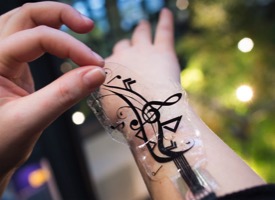
Dr. Carmel Majidi
Clarence H. Adamson Professor, Mechanical Engineering, Biomedical Engineering, Robotics, and Civil and Environmental Engineering
- Scaife Hall 409
- 412 268 2492
- 412 268 3348
Scaife Hall 409
Carnegie Mellon University
5000 Forbes Avenue
Pittsburgh, PA 15213
Education
- B.S., Civil & Environmental Engineering, Cornell University, 2001
- M.S., Electrical Engineering & Computer Sciences, University of California, Berkeley, 2004
- Ph.D., Electrical Engineering & Computer Sciences, University of California, Berkeley, 2007
- Postdoctoral Fellow, Princeton Institute for the Science & Technology of Materials (PRISM), Princeton University, 2007 - 2009
- Postdoctoral Fellow, School of Engineering & Applied Sciences (SEAS), Harvard University, 2009 - 2011
Bio
My career mission is to discover materials, hardware architectures, and fabrication methods that allow robots and machines to behave like soft biological organisms and be safe for contact with humans. The aim is to replace the bulky and rigid hardware in existing robots with soft, lightweight, and deformable technologies that match the functionality of natural biological tissue. Currently, my group is focused on filled-elastomer composites and soft microfluidic systems that exhibit unique combinations of mechanical, electrical, and thermal properties and can function as “artificial” skin, nervous tissue, and muscle for soft robotics and wearables. I’m particularly interested in approaches that are practical from a rapid prototyping and robotics implementation perspective. This includes efforts to enable robust mechanical and electrical interfacing between soft-matter systems and conventional microelectronics and hardware.
Research
I lead the Integrated Soft Materials Lab for human-compatible machines and electronics. Our goal is to discover materials, hardware architectures, and fabrication methods that allow robots and machines to behave like soft biological organisms and be safe for contact with humans. The aim is to replace the bulky and rigid hardware in existing robots with soft, lightweight, and deformable technologies that match the functionality of natural biological tissue. Currently, my group is focused on the following two research thrusts:
- Artificial Skin Electronics: Development of filled-elastomer composites and soft microfluidic systems that exhibit unique combinations of mechanical, electrical, and thermal properties and can function as “artificial” skin, nervous tissue, and muscle for soft robotics and wearables.
- Untethered Soft Robots: Novel material architectures and manufacturing methods to create soft, biologically-inspired robots that function on their own without dependency on external hardware. This includes efforts to enable robust mechanical and electrical interfacing between soft-matter systems and conventional microelectronics and hardware.
Research Interests: elastically soft sensors and circuits; soft multifunctional materials; soft lithography fabrication

Awards and Recognition
-
Young Investigator Awards from NASA, DARPA, Navy, and Air Force